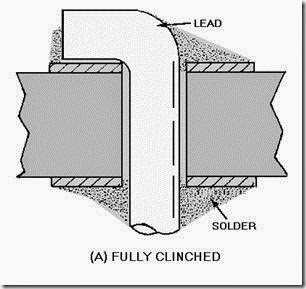REMOVAL AND REPLACEMENT OF DISCRETE COMPONENTS
To properly perform the required repair, the 2M technician must be knowledgeable of the techniques used by manufacturers in the production of electronic assemblies. The techniques, materials, and types of components determine the repair procedures used.
Interconnections and Assemblies
Assemblies may range from simple, single-sided boards with standard-sized components to double- sided or multilayered boards with miniature and microminiature components. The variations in component lead termination and mounting techniques used by manufacturers present the technician with a complex task. For example, the 2M technician is concerned about the type of solder joints on the module. To determine the solder joint type, the technician must consider the board circuitry, hole reinforcement, and lead termination style.
Recall the discussion from topic 1 on printed circuit board construction and the types of interconnections used. Single-sided and some double-sided boards have UNSUPPORTED HOLES where component leads are soldered to the pad. The clearance-hole method is also an interconnection with no hole support. SUPPORTED HOLES are those that have metallic reinforcement along the hole walls.
In addition to the plated-through hole you studied earlier, EYELETS, shown in figure 3-4, view (A), view (B), and view (C), are also used in both manufacturing and repair. These hole-reinforcing devices are usually made of pure copper, but are often plated with gold, tin, or a tin-lead alloy. The copper-based eyelet is pliable; when set, it reduces the possibility of circuit board damage. Eyelets may be inserted into single-sided or double-sided boards and are of three different types – ROLL SET, FUNNEL SET, and FLAT SET. All three are types referred to as INTERFACIAL CONNECTIONS. Interfacial connections identify the procedure of connecting circuitry on one side of a board with the circuitry on the other side.
Figure 3-4A.—Eyelets (interfacial connections). ROLL SET
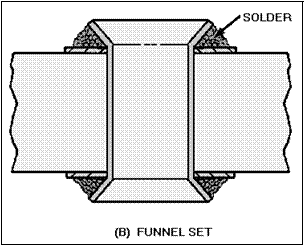 Figure 3-4B.—Eyelets (interfacial connections). FUNNEL SET
Figure 3-4B.—Eyelets (interfacial connections). FUNNEL SET
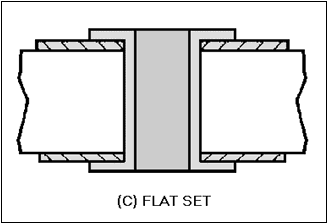 Figure 3-4C.—Eyelets (interfacial connections). FLAT SET
Figure 3-4C.—Eyelets (interfacial connections). FLAT SET
As you can see, the flat-set eyelet actually provides reinforcement for the pads on both sides of the circuit board and reinforces the hole itself. The design of the roll-set eyelet (which may trap gasses, flux, or other contaminants, and obscures view of the finished solder flow) is not acceptable as a repair technique. The funnel-set eyelet does not provide as much pad reinforcement as the other types. However, it provides better "outgassing" of flux, moisture, or solvents from the space between the eyelet and the hole wall. It also provides a better view of the finished solder connection than the roll-set eyelet.
Lead Terminations
The finished circuit board consists of conductive paths, pads, and drilled holes with components and/or wires assembled directly to it. Leads and wires may terminate in three ways: (1) through the hole in the board, (2) above the surface of the board, or (3) on the surface of the board.
THROUGH-HOLE TERMINATION.—This style provides extra support for the circuit pads, the hole, and the lead by a continuous solder connection from one side of the circuit board to the other. Three basic variations of through-hole termination are the CLINCHED LEAD (two types), STRAIGHT- THROUGH LEAD, and OFFSET PAD.
Clinched Lead.—The clinched-lead termination is usually used with unsupported holes, but is found with supported holes as well. Both clinched-lead types, FULLY CLINCHED and SEMICLINCHED (figure 3-5), provide component stability. Like the fully clinched lead, the semi-clinched lead also provides stability during assembly. However, this termination can be easily straightened to allow removal of the solder joint should rework or repair be required. Note that the fully clinched lead is bent 90 degrees while the semiclinched lead is bent 45 degrees.
Figure 3-5A.—Clinched leads. FULLY CLINCHED.
Figure 3-5B.—Clinched leads. SEMICLINCHED
Straight-Through Lead.—Straight-through terminations (figure 3-6) are used by manufacturers when the termination stability is not a prime consideration. This termination type may also be used with unsupported holes. The through-hole termination provides a better, solder-joint contact area and more solder support; the solder runs from the component side to the conductor. The straight-through termination is the easiest to remove and rework.
 Figure 3-6.—Straight-through termination.
Figure 3-6.—Straight-through termination.
The Offset-Pad Termination.—This termination, shown in view (A) of figure 3-7, is a variation of clinch-lead termination. The pad is set off from the centerline of the hole. The lead clinch is also offset from the hole centerline so that it may contact the pad [view (B)].
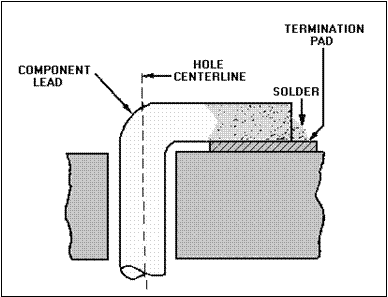 Figure 3-7A.—Offset pad termination SIDE VIEW.
Figure 3-7A.—Offset pad termination SIDE VIEW.
 Figure 3-7B.—Offset pad termination TOP VIEW
Figure 3-7B.—Offset pad termination TOP VIEW
ABOVE-THE-BOARD TERMINATION.—Above-the-board termination is accomplished through the use of terminals or posts. Terminals are used for a variety of reasons. The type of terminal depends on its use. Although many configurations are used, all terminals fall into one of the five categories covered in this section [figure 3-8, views (A) through (E)].
 Figure 3-8A.—Terminals. PIN AND TERMINALS.
Figure 3-8A.—Terminals. PIN AND TERMINALS.
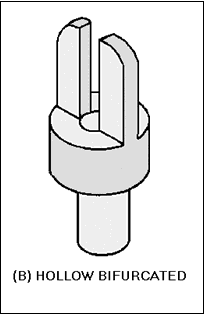 Figure 3-8B.—Terminals. HOLLOW.
Figure 3-8B.—Terminals. HOLLOW.
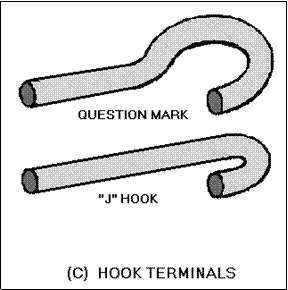 Figure 3-8C.—Terminals. HOOK TERMINALS.
Figure 3-8C.—Terminals. HOOK TERMINALS.
Figure 3-8D.—Terminals. PIERCED TERMINALS.
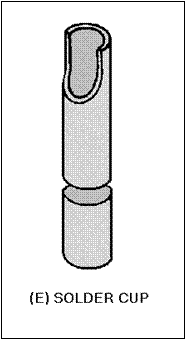 Figure 3-8E.—Terminals. SOLDER CUP
Figure 3-8E.—Terminals. SOLDER CUP
-
· PIN TERMINALS AND TURRET TERMINALS [view (A)] are single-post terminals, either insulated or uninsulated, solid or hollow, stud or feed-through. Stud terminals protrude from one side of a board; feed-throughs protrude from both sides.
-
· BIFURCATED OR FORK TERMINALS [view (B)] are solid or hollow double-post terminals.
-
· HOOK TERMINALS [view (C)] are made of cylindrical stock formed in the shape of a hook or question mark.
-
· PERFORATED OR PIERCED TERMINALS [view (D)] describe a class of terminals that uses a hole pierced in flat metal for termination (e.g., terminal lugs).
-
· SOLDER CUP TERMINALS [view (E)] are a common type found on connectors. Turret and bifurcated terminals are used for interfacial connections on printed circuit boards, terminal points for point-to-point wiring, mounting components, and as tie points for interconnecting wiring. Hook terminals are used to provide connection points on sealed devices and terminal boards.
Terminals used for wire or component lead terminations are normally made of brass with a solderable coating. Uninsulated terminals may be installed on an insulating substrate to form a terminal board. They may also be added to a printed circuit board or installed on a metal chassis. Insulated terminals are installed on a metal chassis.
ON-THE-BOARD TERMINATION.—On-the-board termination (figure 3-9) is also called LAP FLOW termination. In a lap flow solder termination, the component lead does not pass through the circuit board. This form of planar mounting may be used with both round and flat leads.
 Figure 3-9.—On-the-board termination.
Figure 3-9.—On-the-board termination.
Q6. What term is used to identify the procedure of connecting one side of a circuit board with the other?
Q7. Name two types of through-hole termination.
Q8. Turret, bifurcated, and hook terminals are used for what type of termination?
Q9. When a lead is soldered to a pad without passing through the board, it is known as what type of termination?


